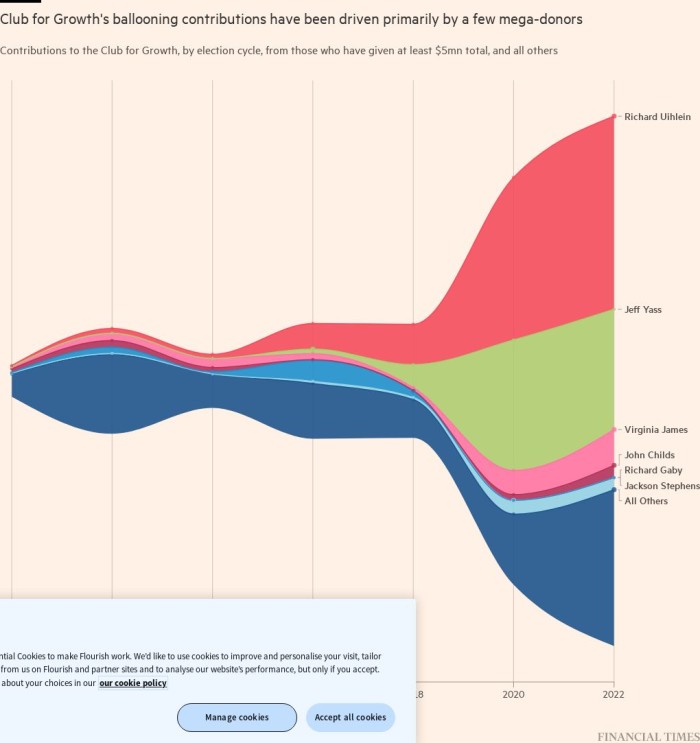[ad_1]
A new class of political donors is funnelling millions of dollars to far-right Republicans, as growing dissatisfaction with the party establishment fuels support for hardline causes such as resistance to raising the US borrowing limit.
Unlike previous generations of conservative megadonors — often Wall Street types who poured money into major fundraising vehicles — the new, more geographically diverse cohort is making targeted donations to far-right candidates and the groups supporting them.
As a result, rightwing groups including the anti-tax Club for Growth and House Freedom Action, a political action committee that supports lawmakers in the hard-right House Freedom Caucus, are wielding increasing leverage over key issues.
“Donors want to win. And we haven’t won an election in a long time,” said Alex Conant, a Republican strategist who worked on Florida senator Marco Rubio’s 2016 presidential bid. “So you know, I don’t think anyone should be surprised that there’s some grumbling among donors over wanting to find more electable candidates.”
Typifying the new cohort are newcomer donors such as David Frecka, the former owner of an Ohio-based packaging company, Next Generation, and his wife, Brenda, who gave $1.5mn to House Freedom Action in the 2022 cycle.*
They also gave $1.15mn to the Right Women Pac, a group that supported seven of the most conservative female House candidates in the last cycle, including Marjorie Taylor Greene and Lauren Boebert, as well as $1mn to Club for Growth.
Other major donors include Tim Dunn, the Midlands Texas oil billionaire whose spending on more conservative candidates has increased considerably since 2018, and John W Childs, the Florida-based private equity billionaire who has cut large cheques to Club for Growth, the Right Women Pac, Greene and Boebert.
The new class of donors, which includes party stalwarts who have shifted rightward and newcomers brought in during Donald Trump’s presidency, has helped fuelled a jump in overall contributions for rightwing groups in recent years.
“When Trump became the nominee, a lot of the Bush, Romney and McCain donors simply threw up their hands and left the party,” said one Republican Pac strategist. “When they left, it was obviously a donor vacuum. And a lot of donors who weren’t previously engaged stepped up to fill the vacuum.”
While the Republican party has historically drawn some of its biggest-name donors from coastal metropolitan hubs, the increasingly influential conservative backers come from a broader swath of the country, particularly Florida, Texas and the Midwest.
Roy Bailey, a Texas fundraiser who served as national co-chair of Trump’s joint fundraising operation with the RNC, said it was “literally hard to keep with” the number of new donors from his state. “Because the wealth in Texas continues to just expand, entrepreneurs just pop up everywhere,” he said.
In the 2022 election cycle, Club for Growth raised $82.3mn in individual donations, compared to $17.4mn in the previous midterm election cycle, according to Federal Election Commission data. House Freedom Action, meanwhile, spent close to $5.2mn in the last election cycle, according to the FEC, more than three times the group’s spending on the 2018 elections.
The rise of thisese new class of donors comes as some prominent GOP megadonors — including Ken Griffin and Stephen Schwarzman — have urged the party to move on from the former president but continue to be in favour of many of the policy positions he helped spearhead.**
David McIntosh, Club for Growth’s president, said many donors were calling for lawmakers to take a more conservative approach in Congress, particularly with regards to fiscal policy.
“I think you’re seeing a shift among the donors away from the dominant party [Pacs] . . . where they’re looking for groups like Club for Growth and other groups that are focused on the conservative agenda,” said McIntosh.
While most members of the House Freedom Caucus ultimately agreed to back Kevin McCarthy’s bid for Speaker of the House of Representatives earlier this year, they did so only after securing concessions including a promise that he would use the position to take a tough stance on raising the US borrowing limit.
That has led to a tense partisan stand-off that could result in an unprecedented default as soon as July if the debt ceiling is not raised, the Congressional Budget Office has warned.
Among Club for Growth’s biggest donors is Richard Uihlein, the billionaire owner of Uline, the Midwestern packaging and shipping supplies company, who has long supported far-right challengers to the Republican establishment, and is also one of the biggest donors of House Freedom Action.
As well as supporting fiscal conservatives, Uihlein has also been a major backer of other rightwing social causes and candidates, including the country’s biggest anti-abortion political action committee and a group supporting gun rights. He was also one of the biggest financial backers of the pro-Trump “March to Save America” rally in Washington that preceded the riots on January 6 2021.
One top Republican strategist close to Club for Growth said the recent rocky leadership votes for McCarthy and Ronna McDaniel of the Republican National Committee were further evidence “of the age-old issue of the donors and politicians not being aligned”.
McIntosh said many donors had been disillusioned by the perceived chaos behind the last election cycle, where much of the news had been consumed by reports of infighting between two of the main Republican Senate Pacs.
“They’re all getting meaningful conservative challengers to shake up the way we’re doing things, because people don’t like it,” he said.
*The donation amount has been updated
**The story has been amended to clarify that Ken Griffin has been a Republican donor but not a financial supporter of Donald Trump’s election campaign
[ad_2]
Source link


